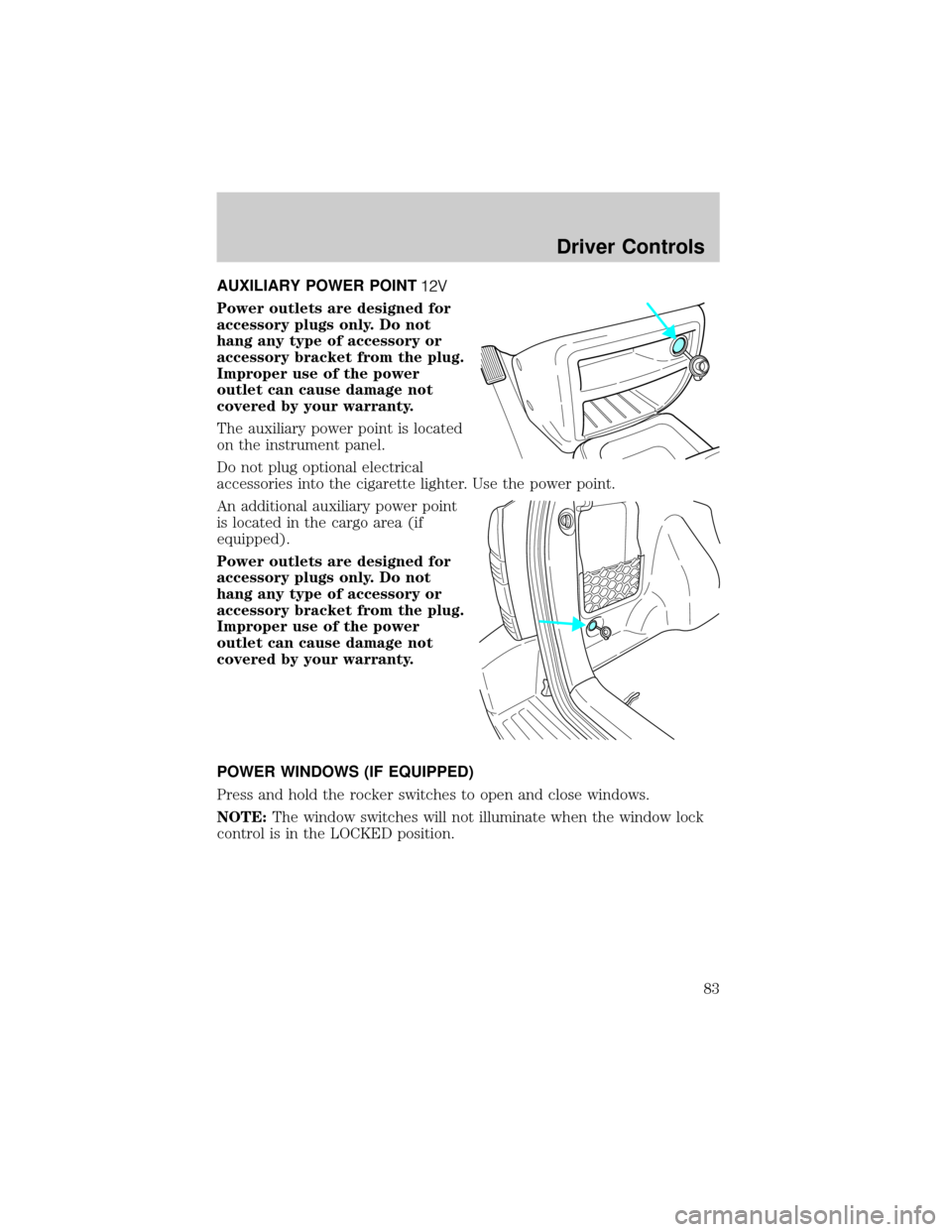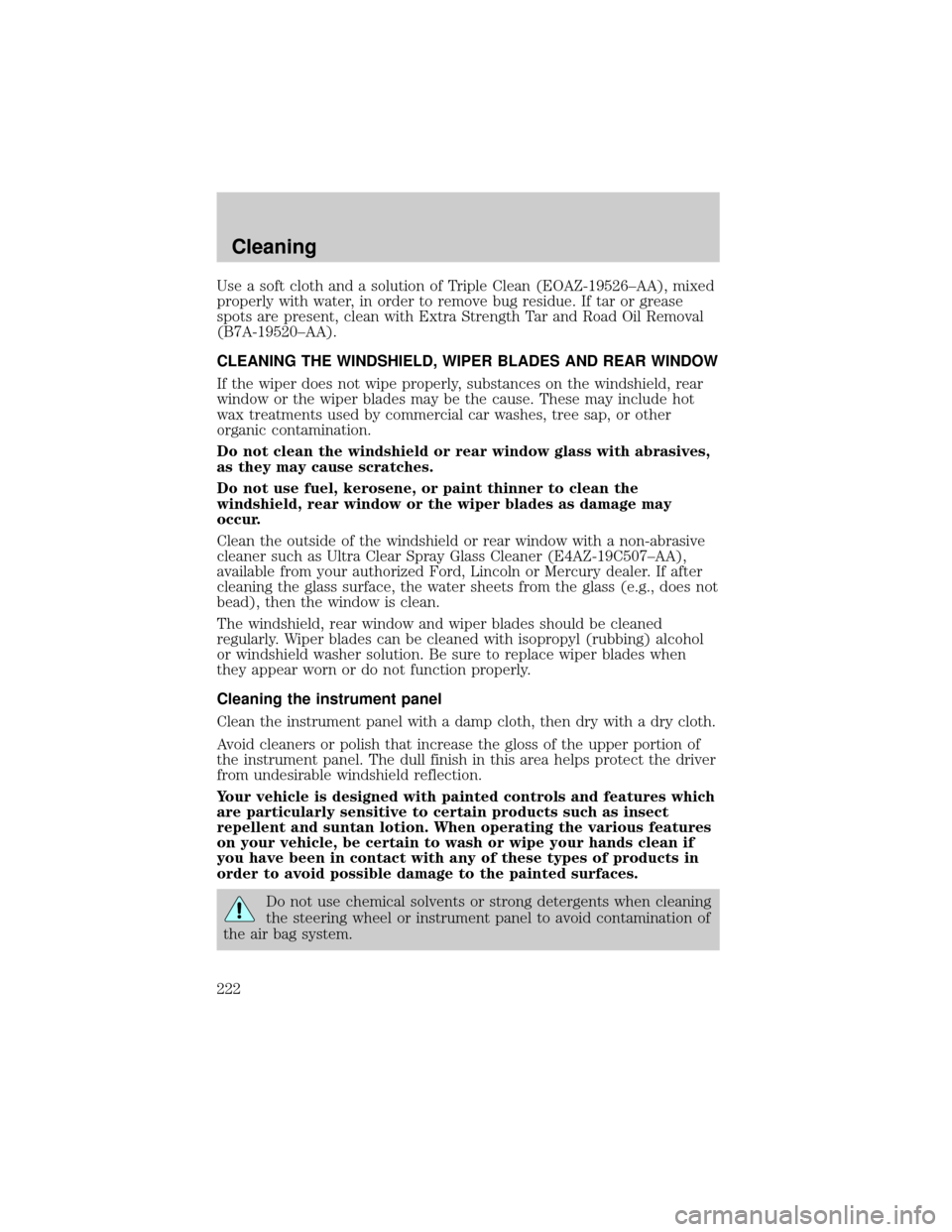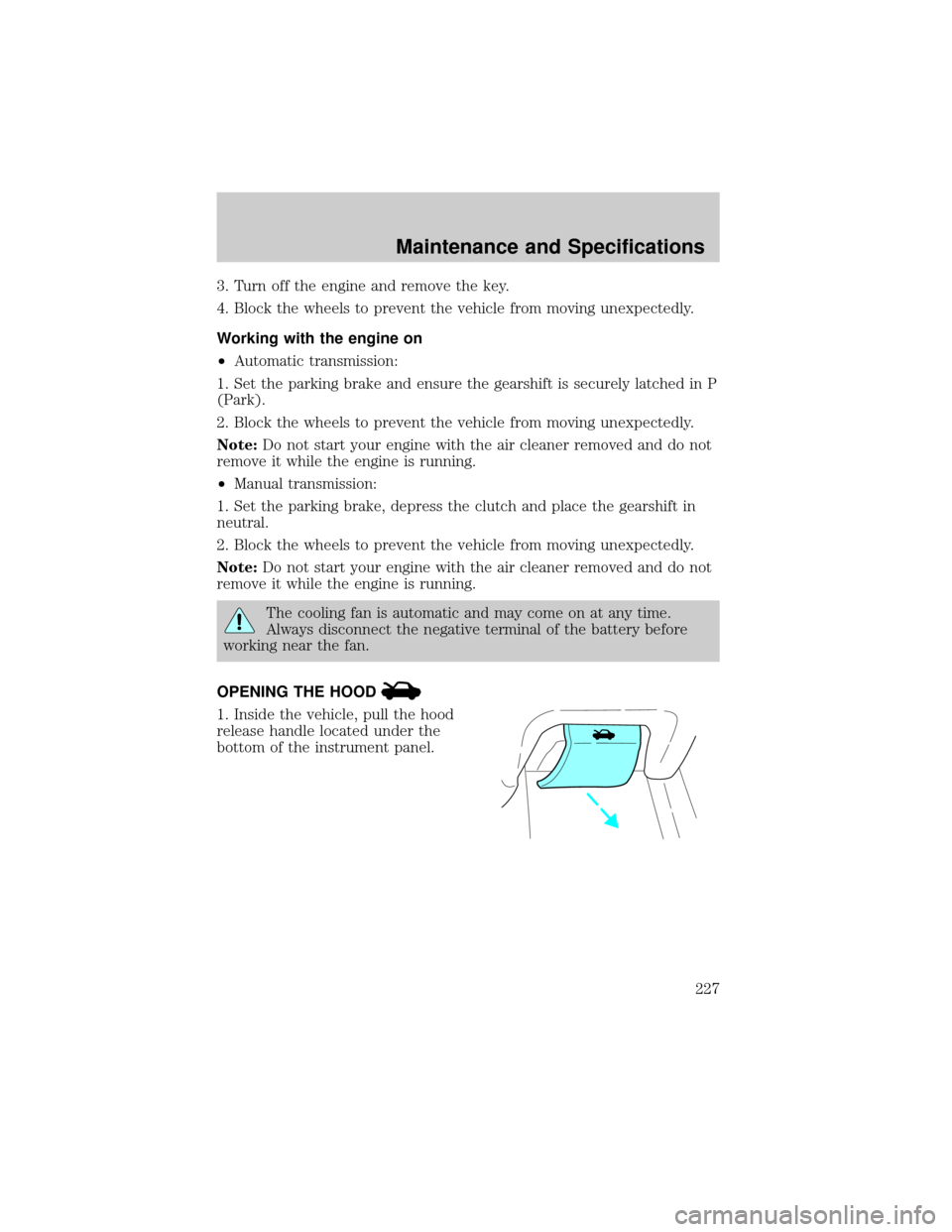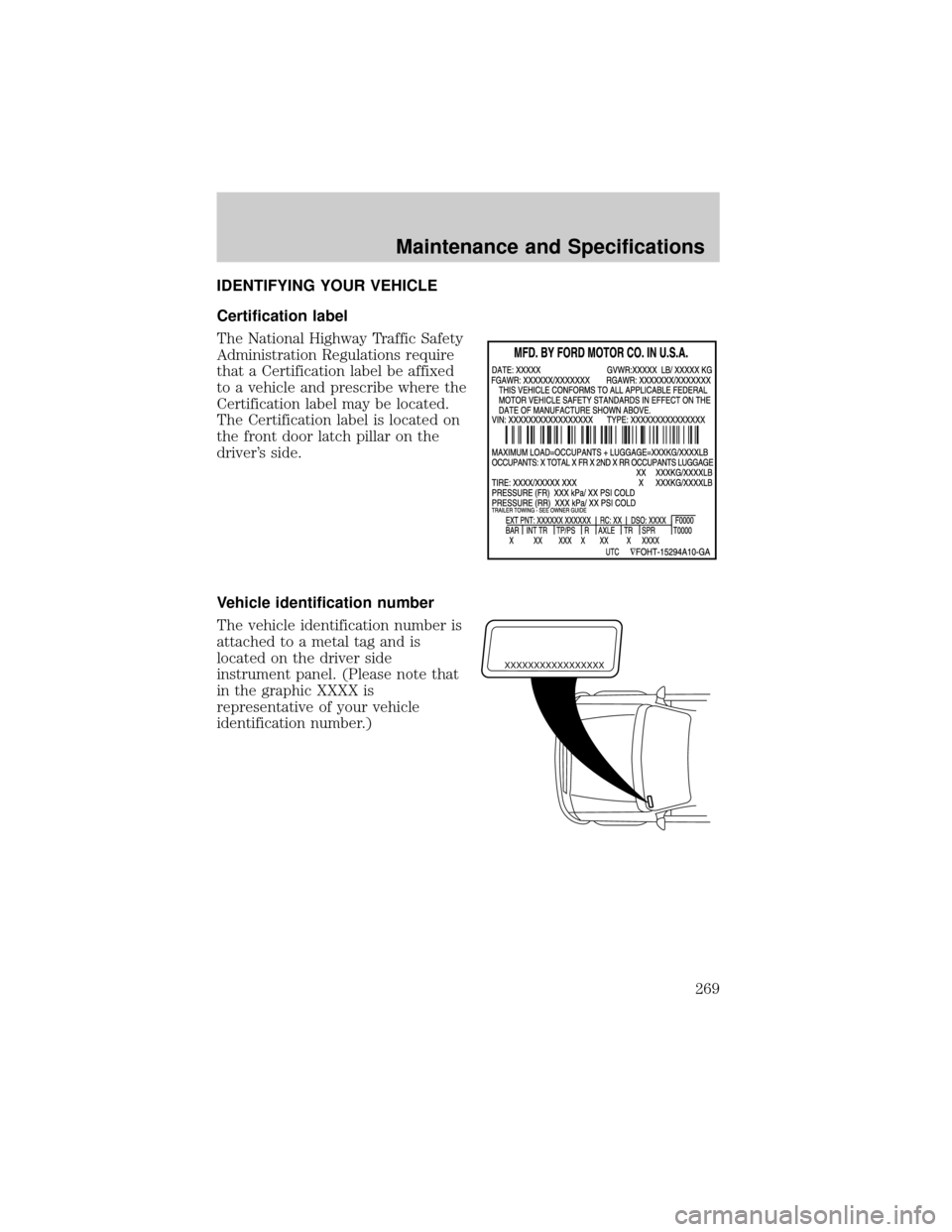2002 FORD ESCAPE instrument panel
[x] Cancel search: instrument panelPage 73 of 280

BULBS
Replacing exterior bulbs
Check the operation of the following lamps frequently:
²Headlamps
²Foglamps
²High-mount brakelamp
²Brakelamps
²Parking lamps
²Turn signal lamps
²License plate lamp
²Tail lamps
²Back-up lamps
Do not remove lamp bulbs unless they can be replaced immediately with
new ones. If a bulb is removed for an extended period of time,
contaminants may enter the lamp housings and affect lamp performance.
Using the right bulbs
Replacement bulbs are specified in the chart below. Headlamp bulbs must
be marked with an authorized ªD.O.T.º for North America and an ªEº for
Europe to assure lamp performance, light brightness and pattern and safe
visibility. The correct bulbs will not damage the lamp assembly or void the
lamp assembly warranty and will provide quality bulb burn time.
Function Number of bulbs Trade number
Park/turn lamps (front) 2 3157 AK (amber)
Headlamps 2 HB2
Rear stop/tail/sidemarker 2 3157K
Rear turn lamps 2 3156K
Backup lamp 2 3156K
Foglamp (front) 2 898
Center High-mount stop lamp 5 168
Rear license plate lamp 2 W5W
All replacement bulbs are clear in color except where noted.
To replace all instrument panel lights - see your dealer.
Lights
73
Page 83 of 280

AUXILIARY POWER POINT
Power outlets are designed for
accessory plugs only. Do not
hang any type of accessory or
accessory bracket from the plug.
Improper use of the power
outlet can cause damage not
covered by your warranty.
The auxiliary power point is located
on the instrument panel.
Do not plug optional electrical
accessories into the cigarette lighter. Use the power point.
An additional auxiliary power point
is located in the cargo area (if
equipped).
Power outlets are designed for
accessory plugs only. Do not
hang any type of accessory or
accessory bracket from the plug.
Improper use of the power
outlet can cause damage not
covered by your warranty.
POWER WINDOWS (IF EQUIPPED)
Press and hold the rocker switches to open and close windows.
NOTE:The window switches will not illuminate when the window lock
control is in the LOCKED position.
Driver Controls
83
Page 187 of 280

ROADSIDE COVERAGE BEYOND BASIC WARRANTY
In the United States, you may purchase additional roadside assistance
coverage beyond this period through the Mazda Auto Club by contacting
your Mazda dealer.
Similarly in Canada, for uninterrupted Roadside Assistance coverage, you
may purchase extended coverage prior to your Basic Warranty's Roadside
Assistance expiring. For more information and enrollment, contact
1±877±294±2582 or visit our website at www.mazda.ca.
HAZARD FLASHER CONTROL
Use only in an emergency to warn traffic of vehicle breakdown,
approaching danger, etc. The hazard flashers can be operated when the
ignition is off.
²The hazard lights control is
located on the instrument panel
by the radio.
²Depress hazard lights control to
activate all hazard flashers
simultaneously.
²Depress control again to turn the
flashers off.
FUEL PUMP SHUT-OFF SWITCH
FUEL
RESET
The fuel pump shut-off switch is a device intended to stop the electric
fuel pump when your vehicle has been involved in a substantial jolt.
After a collision, if the engine cranks but does not start, the fuel pump
shut-off switch may have been activated.
Roadside Emergencies
187
Page 222 of 280

Use a soft cloth and a solution of Triple Clean (EOAZ-19526±AA), mixed
properly with water, in order to remove bug residue. If tar or grease
spots are present, clean with Extra Strength Tar and Road Oil Removal
(B7A-19520±AA).
CLEANING THE WINDSHIELD, WIPER BLADES AND REAR WINDOW
If the wiper does not wipe properly, substances on the windshield, rear
window or the wiper blades may be the cause. These may include hot
wax treatments used by commercial car washes, tree sap, or other
organic contamination.
Do not clean the windshield or rear window glass with abrasives,
as they may cause scratches.
Do not use fuel, kerosene, or paint thinner to clean the
windshield, rear window or the wiper blades as damage may
occur.
Clean the outside of the windshield or rear window with a non-abrasive
cleaner such as Ultra Clear Spray Glass Cleaner (E4AZ-19C507±AA),
available from your authorized Ford, Lincoln or Mercury dealer. If after
cleaning the glass surface, the water sheets from the glass (e.g., does not
bead), then the window is clean.
The windshield, rear window and wiper blades should be cleaned
regularly. Wiper blades can be cleaned with isopropyl (rubbing) alcohol
or windshield washer solution. Be sure to replace wiper blades when
they appear worn or do not function properly.
Cleaning the instrument panel
Clean the instrument panel with a damp cloth, then dry with a dry cloth.
Avoid cleaners or polish that increase the gloss of the upper portion of
the instrument panel. The dull finish in this area helps protect the driver
from undesirable windshield reflection.
Your vehicle is designed with painted controls and features which
are particularly sensitive to certain products such as insect
repellent and suntan lotion. When operating the various features
on your vehicle, be certain to wash or wipe your hands clean if
you have been in contact with any of these types of products in
order to avoid possible damage to the painted surfaces.
Do not use chemical solvents or strong detergents when cleaning
the steering wheel or instrument panel to avoid contamination of
the air bag system.
Cleaning
222
Page 227 of 280

3. Turn off the engine and remove the key.
4. Block the wheels to prevent the vehicle from moving unexpectedly.
Working with the engine on
²Automatic transmission:
1. Set the parking brake and ensure the gearshift is securely latched in P
(Park).
2. Block the wheels to prevent the vehicle from moving unexpectedly.
Note:Do not start your engine with the air cleaner removed and do not
remove it while the engine is running.
²Manual transmission:
1. Set the parking brake, depress the clutch and place the gearshift in
neutral.
2. Block the wheels to prevent the vehicle from moving unexpectedly.
Note:Do not start your engine with the air cleaner removed and do not
remove it while the engine is running.
The cooling fan is automatic and may come on at any time.
Always disconnect the negative terminal of the battery before
working near the fan.
OPENING THE HOOD
1. Inside the vehicle, pull the hood
release handle located under the
bottom of the instrument panel.
Maintenance and Specifications
227
Page 269 of 280

IDENTIFYING YOUR VEHICLE
Certification label
The National Highway Traffic Safety
Administration Regulations require
that a Certification label be affixed
to a vehicle and prescribe where the
Certification label may be located.
The Certification label is located on
the front door latch pillar on the
driver's side.
Vehicle identification number
The vehicle identification number is
attached to a metal tag and is
located on the driver side
instrument panel. (Please note that
in the graphic XXXX is
representative of your vehicle
identification number.)
XXXXXXXXXXXXXXXXX
Maintenance and Specifications
269
Page 275 of 280

Changing a tire .........................195
Child safety restraints ..............145
child safety belts ....................145
Child safety seats ..............145±146
attaching with tether straps ..150
in front seat ............................147
in rear seat ..............................147
Cleaning your vehicle
engine compartment ..............219
exterior ....................................224
instrument cluster lens ..........223
instrument panel ....................222
interior .............................223±224
plastic parts ............................221
safety belts ..............................224
washing ....................................218
waxing .....................................218
wheels ......................................219
windows ..................................223
wiper blades ............................222
woodtone trim ........................223
Climate control (see Air
conditioning or Heating) ......62±63
Clock ..........................24, 33, 43, 59
Clutch
fluid ..........................................256
Console ........................................89
overhead ....................................82
Controls
power seat ...............................114
Coolant
checking and adding ..............237
refill capacities ................241, 262
specifications ..................265, 267
Cruise control
(see Speed control) ....................86
Customer Assistance ................186Ford accessories for your
vehicle .....................................225
Ford Extended
Service Plan ............................210
Getting assistance outside
the U.S. and Canada ..............214
Getting roadside assistance ...186
Getting the service
you need .................................208
Ordering additional owner's
literature .................................215
The Dispute Settlement
Board .......................................211
Utilizing the
Mediation/Arbitration
Program ...................................214
D
Daytime running lamps
(see Lamps) ................................68
Defrost
rear window ..............................67
Dipstick
automatic transmission
fluid ..........................................254
engine oil .................................231
Doors
central unlocking ....................102
door ajar warning .....................13
lubricant specifications ..........265
Driving under special
conditions ..........................172, 174
sand .........................................173
snow and ice ...........................175
through water .................173, 178
Index
275
Page 277 of 280

GVWR (Gross Vehicle
Weight Rating) ..........................178
calculating .......................178, 180
definition .................................178
driving with a heavy load ......178
location ....................................178
H
Hazard flashers .........................187
Head restraints .........................115
Headlamps ...................................68
aiming ........................................70
bulb specifications ....................73
daytime running lights .............68
flash to pass ..............................69
high beam ...........................13, 69
replacing bulbs .........................74
turning on and off ....................68
warning chime ..........................15
Heating
heater only system ...................62
heating and air conditioning
system .......................................63
Hood ..........................................227
I
Ignition ...............................154, 267
Infant seats
(see Safety seats) .............145±146
Inspection/maintenance (I/M)
testing ........................................251
Instrument panel
cleaning ...................................222
cluster ................................10, 223
lighting up panel and
interior .......................................69J
Jack ............................................195
positioning ...............................195
storage .....................................195
Jump-starting your vehicle ......200
K
Keys ...................................107±109
key in ignition chime ...............15
positions of the ignition .........154
L
Lamps
bulb replacement
specifications chart ..................73
cargo lamps ...............................69
daytime running light ...............68
fog lamps ...................................68
headlamps .................................68
headlamps, flash to pass ..........69
instrument panel, dimming .....69
interior lamps ...............71±72, 74
replacing bulbs ...................73±77
Lane change indicator
(see Turn signal) ........................71
Liftgate ........................................90
Lights, warning and indicator ....10
air bag ........................................12
anti-lock brakes (ABS) ....12, 160
anti-theft ...................................14
brake ..........................................11
charging system ........................12
cruise indicator .........................13
door ajar ....................................13
fuel cap light .............................14
high beam .................................13
low coolant ................................14
Index
277